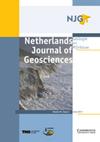英格兰东部中更新世晚期冰川推进的发光年代测定
IF 2.3
2区 地球科学
Q3 GEOSCIENCES, MULTIDISCIPLINARY
Netherlands Journal of Geosciences-Geologie En Mijnbouw
Pub Date : 2021-11-29
DOI:10.1017/njg.2021.13
引用次数: 5
摘要
先前对英格兰东盎格鲁芬兰东部边缘孤立地貌的研究表明,它们代表了一个冰边缘三角洲和冲积扇复合体,沉积在“托滕希尔冰川”(称为“斯克奇利线”)期间进入芬兰的冰瓣边缘。基于区域相关性,它们被归因于晚Wolstonian(即晚Saalian)亚阶段(Drenthe Stadial,早期海洋同位素阶段(MIS) 6)的冰川作用。本文旨在通过直接光学发光测年来测试这种相关性,首次在诺福克郡Shouldham Thorpe和萨福克郡maidcross Hill的Skertchly Line内发现的沉积物,以及在诺福克郡Watlington的相关kame台地沉积物中发现。年龄范围从244±10 ka到12.8±0.46 ka,所有结果都比MIS 8年轻,其中一些结果清楚地表明地貌随后受到冰周过程的影响,特别是在晚侏罗世亚阶段(~ MIS 2)。其余大部分落在169-212 ka范围内,可以被分配到MIS 6,从而证实了先前提出的冰川年龄。讨论了这些结论的局部和区域意义,并将最大冰限与荷兰中部的阿默斯福特-奈梅亨冰川构造脊限联系起来。本文章由计算机程序翻译,如有差异,请以英文原文为准。
Luminescence dating of a late Middle Pleistocene glacial advance in eastern England
Abstract Previous investigation of isolated landforms, on the eastern margin of the East Anglian Fenland, England, has demonstrated that they represent an ice-marginal delta and alluvial fan complex deposited at the margin of an ice lobe that entered the Fenland during the ‘Tottenhill glaciation’ (termed the ‘Skertchly Line’). They have been attributed, based on regional correlations, to a glaciation during the Late Wolstonian (i.e. Late Saalian) Substage (Drenthe Stadial, early Marine Isotope Stage (MIS) 6). This paper aimed to test this correlation by directly optically luminescence dating, for the first time, sediments found within the Skertchly Line at Shouldham Thorpe, Norfolk, and Maidscross Hill, Suffolk, together with those in associated kame terrace deposits at Watlington, Norfolk. Ages ranged from 244 ± 10 ka to 12.8 ± 0.46 ka, all the results being younger than MIS 8 with some clearly showing the landforms have been subsequently subjected to periglacial processes, particularly during the Late Devensian Substage (∼MIS 2). Most of the remainder fall within the range 169–212 ka and could be assigned to MIS 6, thus confirming the previously proposed age of the glaciation. The local and regional implications of these conclusions are discussed, the maximum ice limit being linked to that of the Amersfoort–Nijmegen glaciotectonic ridge limit in the central Netherlands.
求助全文
通过发布文献求助,成功后即可免费获取论文全文。
去求助
来源期刊
CiteScore
4.00
自引率
25.90%
发文量
14
审稿时长
>12 weeks
期刊介绍:
Netherlands Journal of Geosciences - Geologie en Mijnbouw is a fully open access journal which publishes papers on all aspects of geoscience, providing they are of international interest and quality. As the official publication of the ''Netherlands Journal of Geosciences'' Foundation the journal publishes new and significant research in geosciences with a regional focus on the Netherlands, the North Sea region and relevant adjacent areas. A wide range of topics within the geosciences are covered in the journal, including "geology, physical geography, geophyics, (geo-)archeology, paleontology, hydro(geo)logy, hydrocarbon exploration, modelling and visualisation."
The journal is a continuation of Geologie and Mijnbouw (published by the Royal Geological and Mining Society of the Netherlands, KNGMG) and Mededelingen Nederlands Instituut voor Toegepaste Geowetenschappen (published by TNO Geological Survey of the Netherlands). The journal is published in full colour.

 求助内容:
求助内容: 应助结果提醒方式:
应助结果提醒方式:


